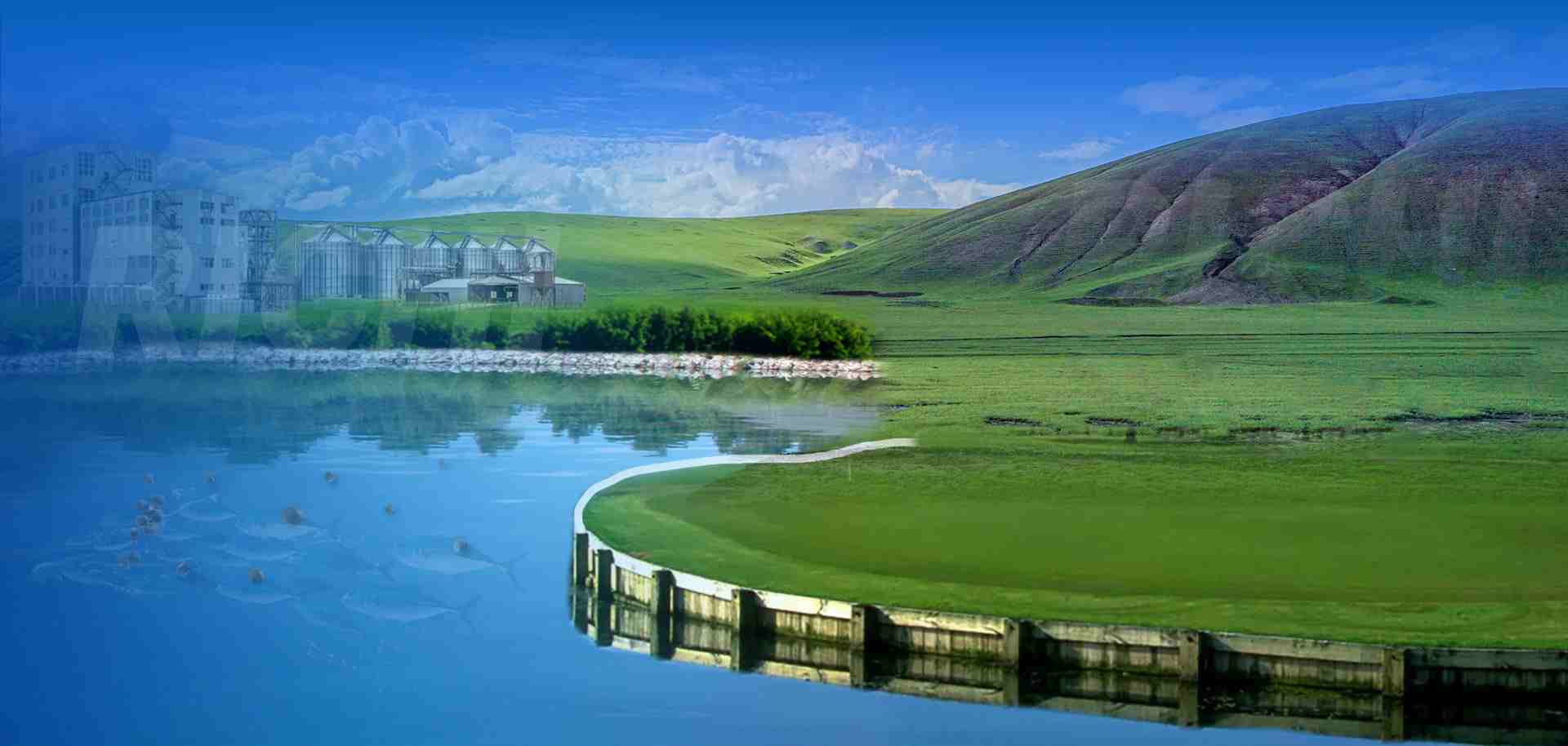
Sinking Fish Feed Machine
Sinking fish feed machine is an indispensable and important equipment in modern aquaculture, which is specially used to produce high-quality sinking fish feed pellets. Through advanced extrusion technology, it can process a variety of raw materials into nutritionally balanced and palatable sinking feed pellets to meet the feeding needs of different fish at various growth stages. Fish feed pellet machines generally use ring die fish feed machines.
Sinking fish feed machines are essential for producing high-quality sinking pellets. Depending on production needs, some customers also choose floating fish feed extruder machine to make floating feed.
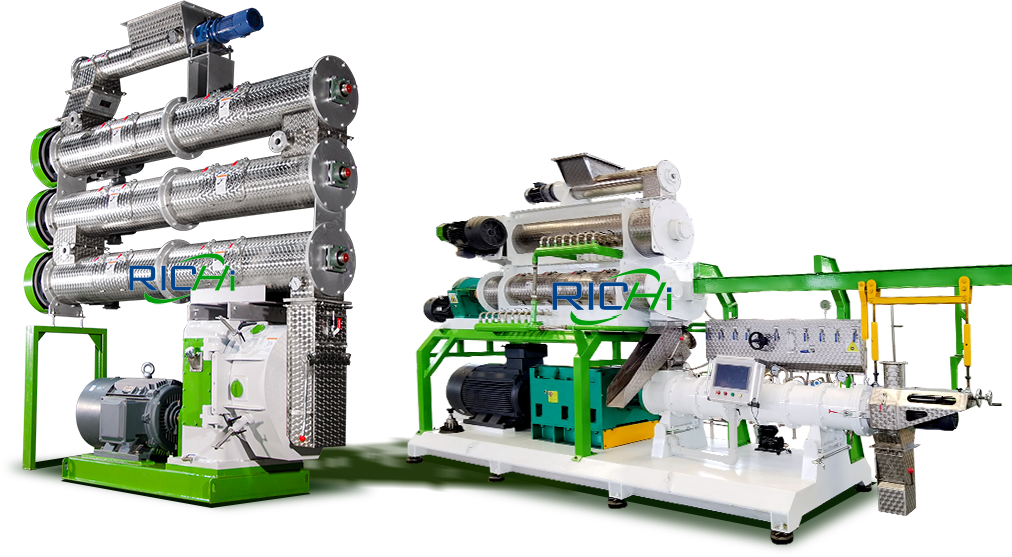
RICHI MACHINERY
Working principle of sinking fish feed machine
Sinking fish feed machine is a kind of equipment specially used for the production of sinking fish feed pellets, which is an indispensable key equipment in the processing of aquatic feed. Its core function is to process powdered compound feed into fish feed pellets with high density, strong sinking, good palatability and balanced nutrition through physical extrusion to meet the feeding needs of fish in different water layers.
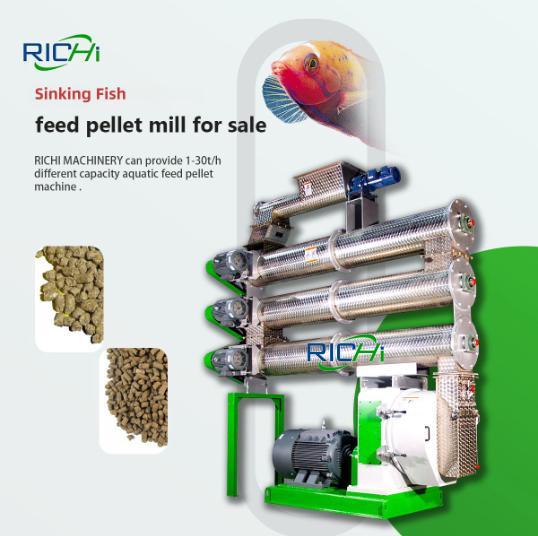
In actual production, the raw materials are first passed through magnetic separation equipment to remove metal impurities to ensure the safe operation of the equipment and the purity of the feed. Subsequently, the materials are evenly fed into the conditioner through a continuously variable speed screw feeder, mixed with steam and heated to gelatinize the starch, denature the protein, and soften the crude fiber in the feed, thereby improving its plasticity and forming properties.
The conditioned materials enter between the ring die and the pressure roller of the sinking fish feed making machine, and the friction of the rotating ring die drives the pressure roller to rotate, realizing continuous high-pressure extrusion of the materials. After the feed is pressed into the die hole, it forms a strip, and is cut into pellets of the required length by an adjustable position cutter at the outlet.
Fish feed pellet making machine not only determines the density and sedimentation speed of the pellets, but also affects the forming rate, stability and nutrient retention rate of the pellets. Through reasonable design and adjustment, it can ensure that the pellets have good sedimentation performance in the water, effectively transport the fish feed to different fish activity water layers, and achieve precise feeding.
RICHI MACHINERY
Sinking fish feed machine production process and trial machine video
In the process of producing high-quality sinking fish food pellets, the Sinking fish feed machine processes and extrude the raw materials through multiple links to ensure that the final pellets have good stability, density and palatability. In order to more intuitively demonstrate the performance of the equipment and the pellet effect, we have specially attached the trial machine video of our customer project. You can see the complete process from raw material feeding to pellet forming, which clearly shows the stability and efficient output capacity of RICHI sinking fish feed pellet mill.
The first is the pretreatment of raw materials. Mix the powdered raw materials (such as soybean meal, rice bran, fish meal, etc.), and add appropriate amount of steam or water if necessary to achieve the ideal humidity and consistency to enhance the subsequent gelatinization and extrusion effect. The processed raw materials will be fed into the main machine barrel, and after being pushed by the screw, they will gradually turn into a dough-like substance with strong plasticity under the action of high temperature, high pressure and shear force.
Next, the material is pushed to the forming mold at the outlet end. The aperture and shape of the mold can be customized according to actual needs to control the diameter and appearance of the pellets. The feed strips extruded through the die will be cut into pellets of uniform length by a high-speed rotating cutter outside the die.
The extruded feed pellets contain a certain amount of water and must be dried to reduce the water content, thereby improving storage stability and shelf life. Our commonly used drying methods include hot air drying, steam drying, etc., to ensure that the moisture content of the pellets is reduced to a safe range. After drying, the pellets are cooled to room temperature by cooling equipment, which helps to enhance their hardness and compressive resistance.
Finally, the cooled sinking fish pellets can be weighed and packaged according to needs, or stored in bulk, suitable for distribution, transportation or on-site use.
RICHI MACHINERY
Fish feed nutrition feed formula of sinking fish feed machine
The nutritional needs of fish are complex and diverse, so the scientific and reasonable preparation of fish feed is crucial to improve the breeding efficiency. Especially in freshwater farms where sinking feeding is the main method, the use of sinking fish pellets can better adapt to the feeding habits of bottom fish, improve feeding efficiency, and reduce feed waste.
In practical applications, based on existing raw materials, protein, fat and carbohydrate formulas suitable for the feeding characteristics of different freshwater fish should be developed to meet the needs of growth and take into account cost control, thereby helping the sustainable development of the freshwater aquaculture industry. When formulating freshwater fish feed formulas, focus on three major nutrients: protein, vitamins and minerals:
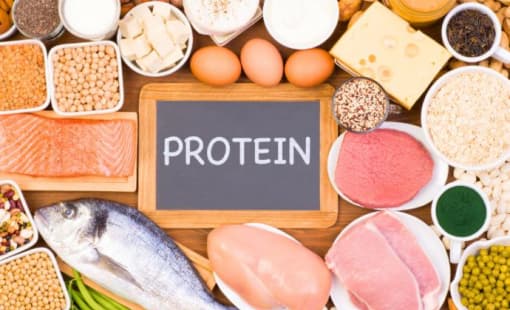
Protein
Fish demand for protein is much higher than that of poultry and livestock, usually 2 to 3 times that of livestock and livestock. Due to the limited ability of fish to utilize carbohydrates, they will use part of the protein as an energy source. Therefore, protein is not only a raw material for building tissues, but also an important source of feed energy. In formula design, we should not only pay attention to the total content of crude protein, but also pay attention to the digestibility of protein (DP) and the reasonable combination of amino acids to improve feed utilization efficiency and control costs.
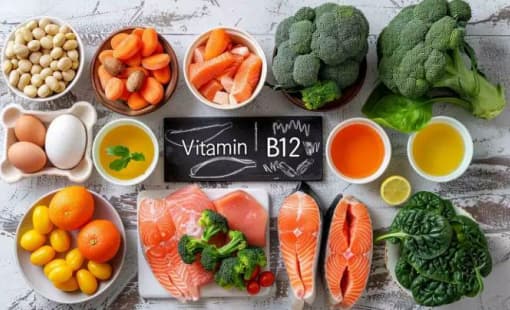
Vitamins
Fish have short intestines and weak ability to synthesize vitamins by themselves, so they need to supplement multiple vitamins from feed. Especially vitamin C, which can be ignored in livestock and poultry feed, but is essential in fish feed. It can effectively enhance the anti-stress ability of fish and promote the health of the immune system. It is a key nutritional factor in maintaining the overall stability of the breeding population.
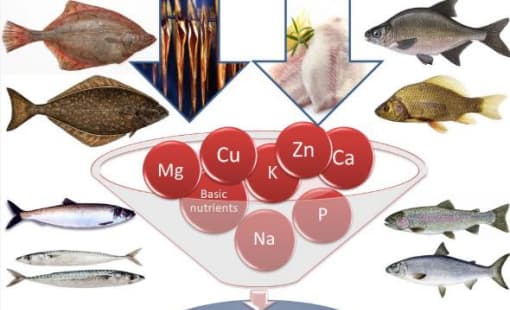
Minerals
Although fish can absorb some minerals (such as calcium) from water through their skin and gills, they still need to supplement a variety of other minerals through feed to maintain normal growth and development. Choosing mineral sources with high bioavailability, such as organic salts or inorganic salts with high absorption rate, can greatly improve the effect of feed. Especially when using sinking fish feed making machines for pelleting, the pellet structure and molding temperature should be accurately controlled to ensure the uniform distribution and stable existence of these trace minerals in the feed, thereby improving the overall nutritional value of the feed.

Customizable Sinking Fish Feed Machine
Different fish species—and even the same species at different growth stages—require specific nutrients to thrive. That’s why feed production must be flexible and precise. With a customizable sinking fish feed machine, farmers can produce tailored feed pellets that match the nutritional needs of various species under different breeding conditions.
By adjusting parameters such as pellet size, protein levels, fat ratios, and additive content, this machine helps ensure each batch of feed supports optimal fish growth, improves feed conversion rates, and reduces the risk of disease. Whether you’re raising catfish, tilapia, or other bottom-feeding fish, a fully adjustable machine allows you to deliver science-based nutrition for better economic results in aquaculture.
RICHI MACHINERY
Features of Sinking fish feed machine
In order for fish to better absorb the nutrients in the feed, not only a scientific formula is needed, but also a good processing equipment is indispensable. Especially when making sinking fish feed, using a professional sinking fish feed machine can not only improve the molding effect of the feed, but also make the production more efficient and labor-saving, and make the feed more stable and palatable in the water.

Sinking fish feed pellet mill is an indispensable core equipment of fish feed production line. With its efficient and stable performance, it is widely used in various farms and feed processing plants. The equipment can accurately control key parameters such as temperature, humidity, and mixing time to ensure the degree of maturation and nutrient retention of the feed during the extrusion process, and ensure that the quality of the produced sinking pellet feed is stable and nutritious, which is more suitable for the feeding needs of fish in different water layers.

In terms of pellet shape and size, the equipment is highly flexible. Users can freely adjust the size and shape of the feed according to the growth stage of different fish, further improve the palatability of the feed, and reduce the waste rate. At the same time, the sinking fish feed pellet extruder machine is equipped with an efficient mixing device, which can fully mix the raw materials to ensure that the nutrients are evenly distributed, each pellet has a consistent nutritional value, and improves the feed utilization rate.

The operation and maintenance of the equipment are also very convenient, and the structural design is humanized, which is easy to clean and maintain daily. A number of safety protection functions are also integrated into the equipment, such as emergency stop buttons, safety interlocks and protective covers, to maximize the safety of operators. In addition, the modern model also supports automatic operation, with a built-in intelligent control system, which can monitor and adjust production line data in real time to achieve intelligent and efficient production.

It is worth mentioning that the sinking fish feed making machine can be seamlessly integrated into the entire feed production line, and work in conjunction with crushing, mixing, cooling, packaging and other links, greatly improving the overall production efficiency and management convenience. Some models also adopt energy-saving design, low operating energy consumption, which helps to reduce operating costs, and at the same time conforms to the concept of green environmental protection, and is an important tool for promoting the high-quality development of the aquatic feed industry.

Price and parameters of Sinking fish feed machine
The price of a sinking fish feed machine is usually between 10,000 and 100,000 USD. Due to different equipment models, configurations, and automation levels, the specific quotation will vary. We also support customization of certain structures and key components to better match your actual production needs. If you are looking for a more compact solution, our small floating fish feed machine is also available — ideal for small-scale farms or entry-level production, offering flexibility at a lower investment cost.
Before the formal quotation, it is recommended that you provide basic information such as raw material type and expected output so that our technical team can recommend the appropriate model for you and develop a detailed plan.
The core parameters of several sinking fish feed pellet extruder machines are listed below for your reference. Feel free to contact us for exclusive selection and price recommendations.
| Model | Output (TPH) | Main motor power (kw) | Feed motor power (kw) | Air conditioning power (kw) | Ring die diameter (mm) |
| SZLH250 | 0.6-1.4 | 22 | 0.75 | 1.5 | 250 |
| SZLH320 | 1.8-2.8 | 37 | 1.5 | 2.2 | 320 |
| SZLH350 | 3-5 | 55 | 1.5 | 3 | 350 |
| SZLH420 | 4.8-8.5 | 90 | 1.5 | 7.5 | 420 |
| SZLH508 | 6-12.5 | 132 | 2.2 | 11 | 508 |
| SZLH558 | 9-17.5 | 180/200 | 2.2 | 11 | 558 |
| SZLH678 | 12-21 | 220/250 | 2.2 | 11 | 678 |
| SZLH768 | 15-28 | 280/315 | 2.2 | 11 | 768 |
| SZLH858 | 15-30 | 280/315 | 2.2 | 15 | 858 |
RICHI MACHINERY
How to identify the quality of fish feed pellets produced by sinking fish feed machines
In modern aquaculture, fish feed pellets have become an indispensable and important part. For farmers who do not have their own fish feed extrusion production line, how to identify the quality of fish feed pellets is particularly critical. Fish feed usually accounts for 50%-70% of the total cost of breeding, and its quality directly affects the growth rate and health of fish. Therefore, choosing “cost-effective” high-quality fish feed is the key to achieving efficient breeding and improving breeding benefits.
Here are some simple and practical methods to help you quickly identify the quality of fish feed pellets:
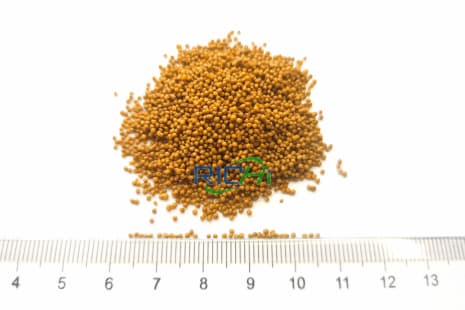
Look at the color
The raw materials of high-quality fish feed usually contain protein substances such as fish meal, soybean meal, rapeseed meal, cottonseed meal, etc., so the pellets are generally yellow-brown or brown. However, it should be noted that the color will vary slightly depending on the source and origin of the raw materials, and even the same formula products produced by the same manufacturer may have slight differences.
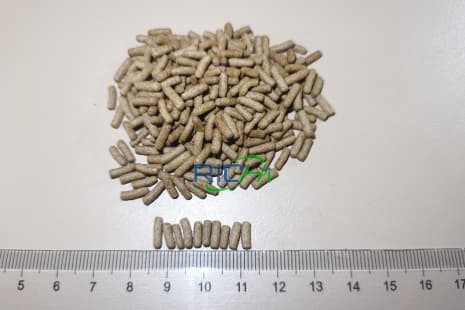
Smell the smell
Normal fish feed will have a faint fishy smell and rapeseed meal smell, and some feeds with added allicin will also have a faint garlic smell. However, some bad manufacturers will add flavoring agents such as flavors to cover up the poor quality of raw materials and improve the “smell” of fish meal. The judgment method is to soak the feed in water. If the fishy smell disappears quickly, there may be flavors added.
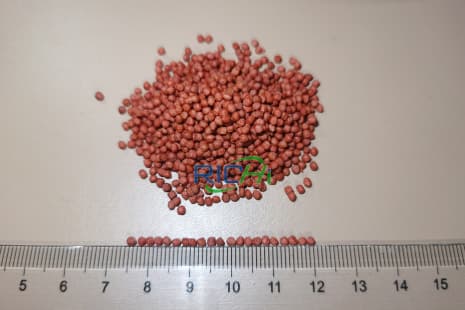
Check the stability in water
Many farmers believe that the stronger the water resistance of the feed, the better. In fact, this is a misunderstanding. Too long water resistance time can easily lead to nutrient loss. The reasonable water stability time should be controlled within 3-6 minutes. Appropriate water resistance helps fish to eat normally and reduce waste.
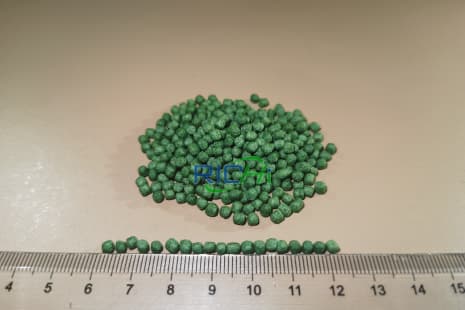
Observe the pellet specifications
Regular manufacturers will provide pellet feeds of various specifications according to the different growth stages of fish. High-quality pellets should be of uniform size, smooth appearance, uniform color, neat fracture, and the length of the pellets is generally 1.5-2.5 times its diameter. Inconsistent pellet specifications can easily affect fish feeding and feed digestion.
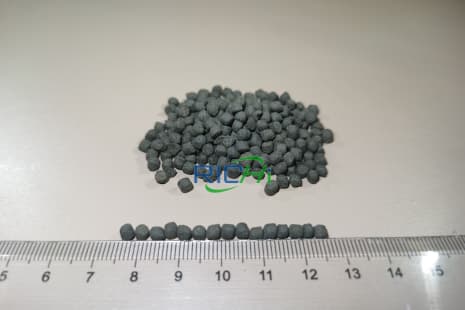
Evaluate the grinding fineness
Fish have limited digestion capacity, so they require a high grinding fineness for feed. High-quality fish feed raw materials are fully crushed, the pellets are uniform inside, the nutrients are easier to absorb, and the feed utilization rate is improved.
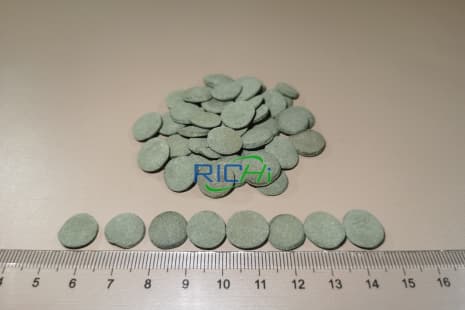
Check for sand and soil adulteration
Some manufacturers will mix sand and soil into the feed to reduce costs. There are two detection methods:
- Taste detection method: taste the pellets with your tongue. If there is a smell of soil, sand and soil may be mixed in.
- Water-soluble detection method: put the fish feed sample into a transparent cup, add water and stir it, and let it stand. If the water is turbid and there is fine sand precipitation at the bottom of the cup, it means that the feed contains sand impurities.
RICHI MACHINERY
Project Cases Of Sinking Fish Feed Machines
RICHI Machinery, with its deep technical accumulation and professional experience in the field of feed machinery, has been deeply involved in the feed breeding industry and is committed to providing diversified solutions for fish feed factories of different sizes. The company’s products are widely used in more than 150 countries and regions including Japan, Canada, Germany, Russia, the United Kingdom, Australia, Chile, etc., serving thousands of customers. Many projects have become local industry benchmarks and help the high-quality development of the global feed industry.
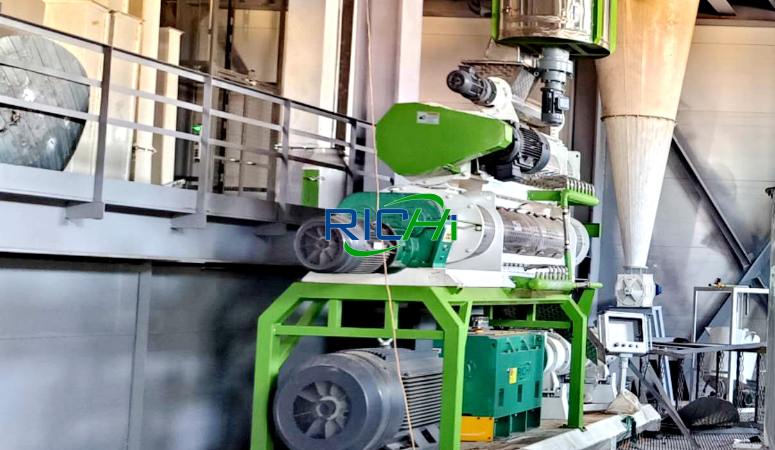
01
Japanese 0.8-1.2 T/H sinking fish feed pellet machine project case
- Country: Japan
- Project type: 0.8-1.2 tons/hour sinking fish feed pellet production line
- Project background: Japan has a developed aquaculture industry, especially focusing on the refined breeding of high economic value fish species such as sea bream, flounder, sea bass, etc., pursuing nutritionally precise and controllable compound feed. The customer is a local small and medium-sized feed company, dedicated to providing customized formula feed for coastal farmers in Japan.
- Main equipment: SZLH350 sinking fish feed machine, ribbon mixer, hammer mill, double-layer cooler, small dryer, automatic packaging system, etc.
- pellet specifications: diameter 2-4mm, length 5-8mm
- Project period: 45 days from contract signing to production
- Operators: 2 people
- Customer needs: Hope to configure a compact and highly intelligent feed production line to meet the processing needs of variable raw materials and adjustable pellet specifications. The energy consumption of the equipment needs to be controlled within a reasonable range to facilitate later expansion.
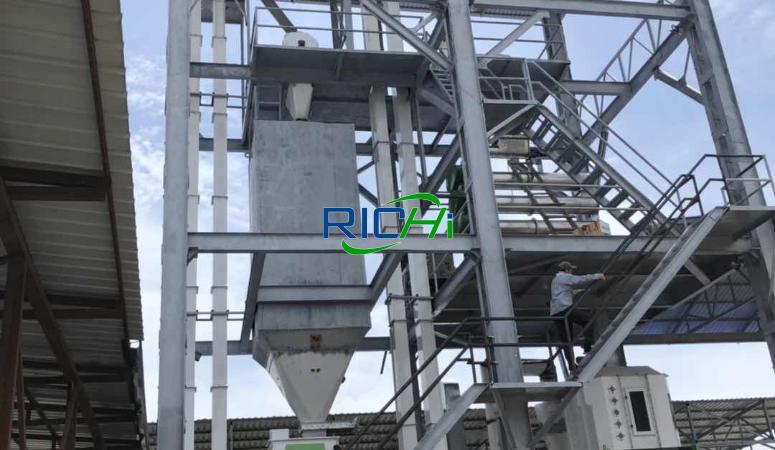
02
South Korea 1-1.5 T/H sinking fish feed pellet machine project case
- Country: South Korea
- Project type: 1-1.5 tons/hour small sinking fish feed processing plant
- Project background: South Korea has a large proportion of marine aquaculture, especially eels and groupers, which are highly dependent on sinking feed. The customer is a specialty aquatic company that plans to build its own feed factory to reduce procurement costs and improve feed nutrition accuracy.
- Main equipment: SZLH420 small sinking fish feed pellet machine, conditioning system, belt conveyor system, rotary grading screen, cooling tower, packaging system, etc.
- pellet specifications: 3.5mm (eel) and 4.5mm (grouper)
- Project period: 50 days from contract signing to delivery
- Operators: 3 people
- Customer needs: Custom feed pellet length and floating adjustment device are required to meet the feeding needs of different fish, and the equipment needs to be easy to operate and maintain, and support later remote technical services.
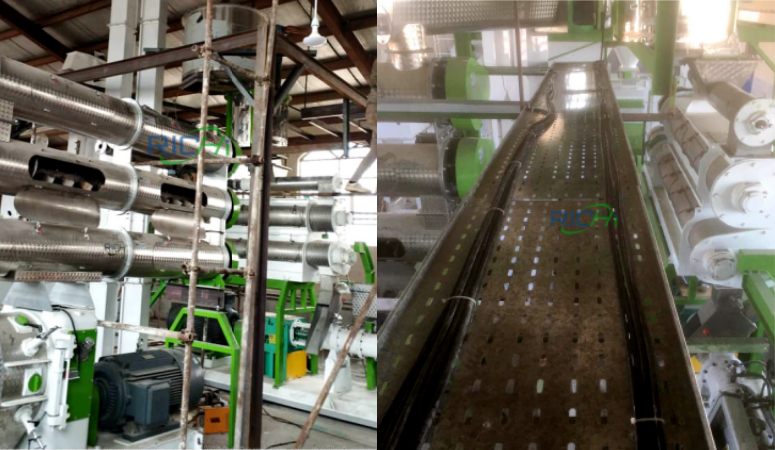
03
Australia 4T/H Intelligent Sinking Feed Factory Project
- Country: Australia
- Project Type: Intelligent Aquatic Feed Factory
- Production Capacity: 4 tons/hour
- Main equipment: SZLH420 sinking pellet machine, PLC automatic control system, double conditioning system, cooling and screening linkage device
- Raw material composition: soybean meal, fish meal, krill meal, plant additives
- pellet diameter: 3mm, 4mm
- Process characteristics: support multi-specification feed switching to meet the needs of different breeding stages
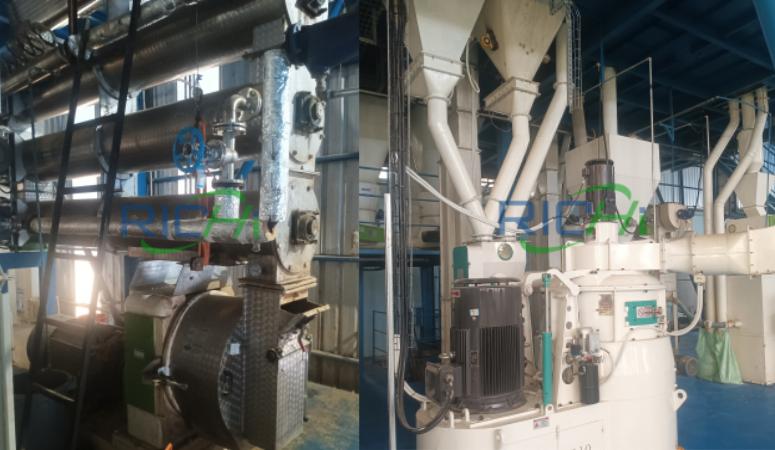
04
USA 5T/H sinking fish feed factory construction project
- Country: United States
- Project Type: Large commercial fish feed factory
- Production Capacity: 5 tons/hour
- Main equipment: SZLH420 sinking fish feed pellet machine, fully automatic batching system, steam conditioning system, vacuum spraying system
- Raw material composition: fish meal, feather meal, soy protein, yeast powder, vitamin additives
- pellet diameter: 3mm, 5mm
- Process characteristics: use vacuum spraying equipment to achieve high-energy fat spraying to improve the palatability of pellets
RICHI MACHINERY
Why Choose RICHI Machinery
Choosing RICHI Machinery means you’ll receive not only high – quality equipment but also one – stop solutions and comprehensive service support. Here are some key reasons to choose us:
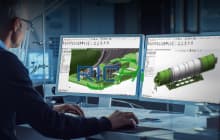
30 years of industry experience
Since its establishment in 1995, RICHI Machinery has amassed 30 years of rich experience in the design, production, and R & D of sinking fish feed machine. With our profound technical accumulation and global development, we can provide our customers with reliable equipment and solutions.

Customized turnkey solutions
We offer a complete turnkey production line, covering project design, equipment manufacturing, installation and commissioning, and personnel training, according to your specific needs. Whether it’s a small farm or a large feed factory, we can tailor a suitable production plan for you.

Complete after – sales service
We have a comprehensive after – sales system, providing you with all – round services from pre – sales consultation to after – sales maintenance. This includes professional and systematic training to help you quickly master equipment operation and maintenance skills and maximize project requirements.

Built Around Your Needs
We can create customized turnkey pellet production line projects based on your unique requirements. For example, we provided customized technical solutions and operation training for the sinking fish feed pellet mill to help the production line operate stably in the long term. You can find us on YouTube.

